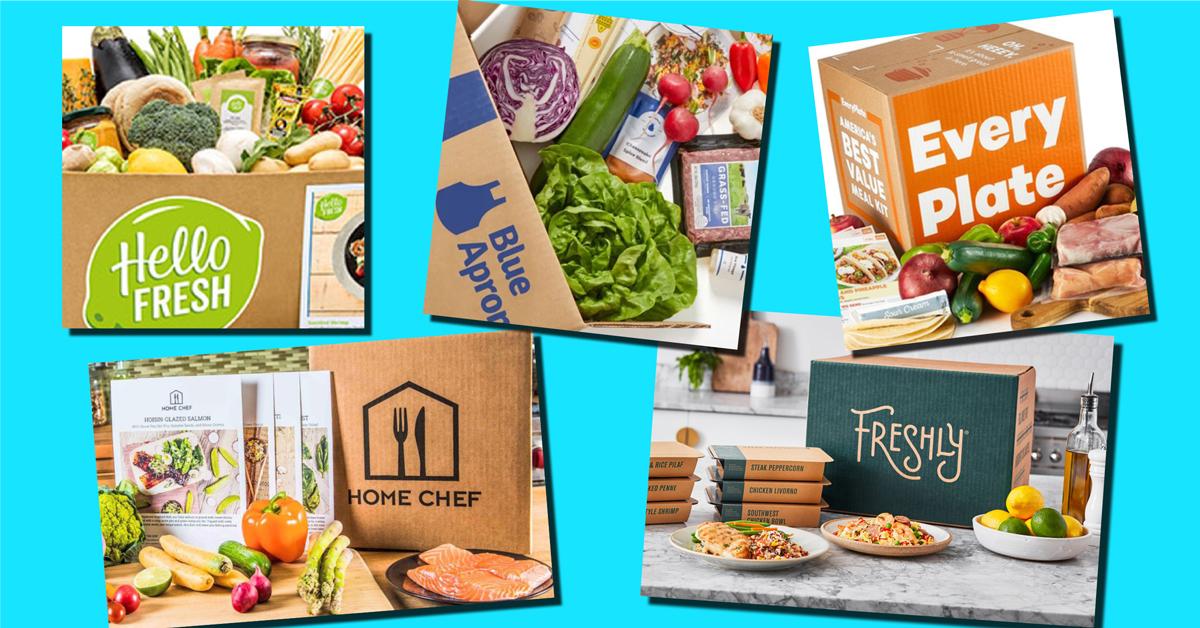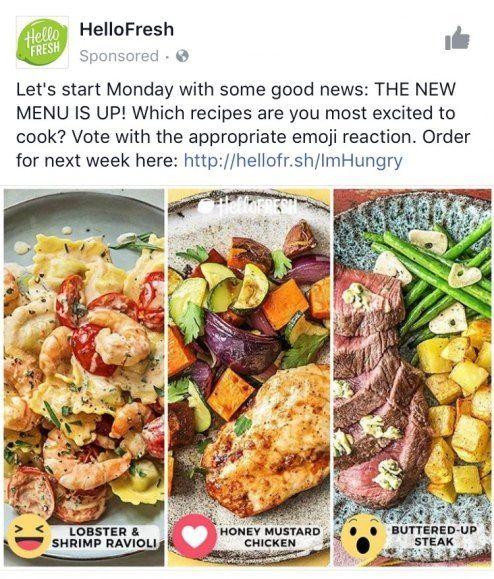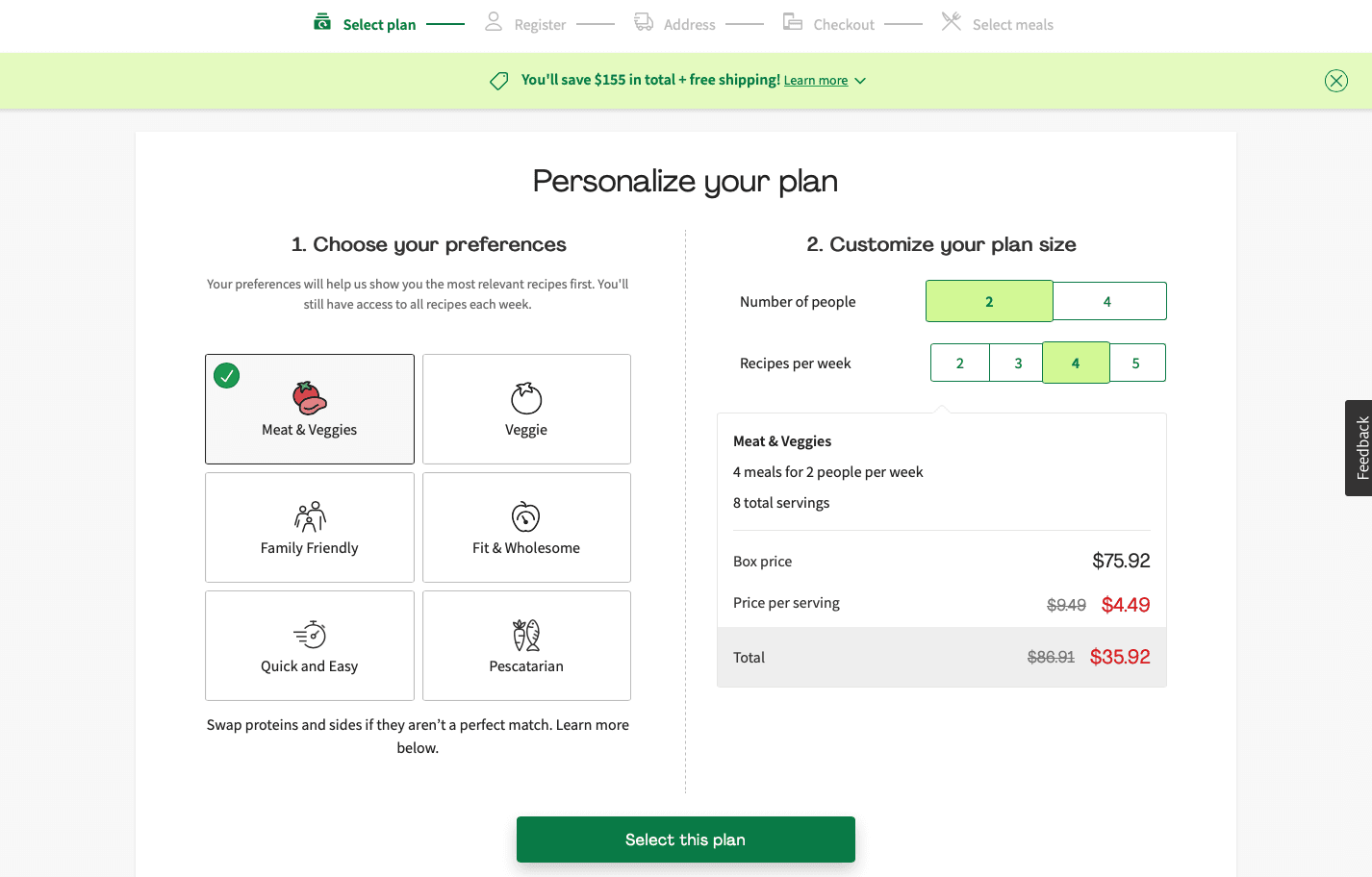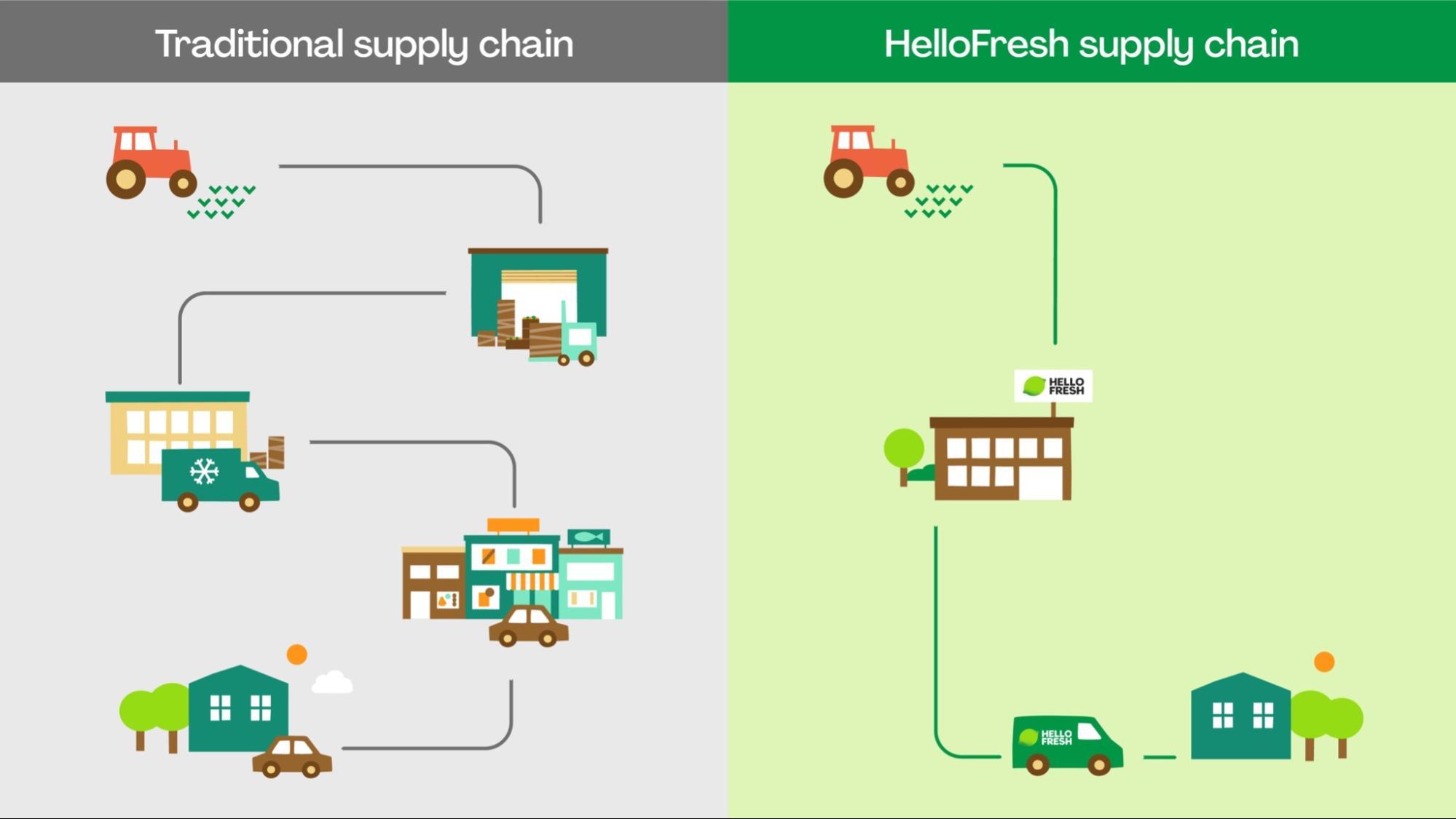Knock, knock, knock! While you might not have anticipated someone at your door a few years ago, getting your groceries delivered right to your house has become increasingly popular. HelloFresh’s marketing strategy centers on this trend, and it’s only getting stronger.
HelloFresh is a popular meal-kit company that delivers pre-portioned ingredients right to their customers’ doors. But how has HelloFresh been able to gain popularity so quickly in a sea of aggressive competitors? The answer lies in their marketing strategy.
Just like with their recipes, you can follow HelloFresh’s marketing strategy step-by-step in this easy-to-follow case study. You’ve got everything you need, so unpack it and let’s get cooking.
HelloFresh History
To understand how HelloFresh got its start, we have to go back to the beginning of a whole different company. Take a trip back to 2007, when German billionaire Oliver Samwer and his brothers decided to create Rocket Internet.
Rocket Internet focused on growing startup companies quickly and efficiently. Their business model was based on seeing what other companies were doing and copying their strategy to build an even better company.
By 2010, Rocket Internet was doing exceptionally well, and Samwer saw a business opportunity he couldn’t pass up. Thus the dawn of a brand new meal-kit delivery service: HelloFresh.
There were already a few meal-kit delivery companies, and he saw an opportunity for it to be better executed. Samwer hired Dominik Richter, Thomas Griesel, and Jessica Nilsson to start HelloFresh in October 2011.
Within three months, they shipped their first meal kit out of the Berlin, Germany, warehouse. Within the next few months, they would accumulate warehouses throughout Australia and Europe, but the time for expansion had a small window.
HelloFresh had competitors, like Blue Apron, planning to launch in the United States in 2012. HelloFresh needed to expand into the U.S. to stay ahead of the game and do it as soon as possible.
Unfortunately, the cost of running a meal-kit delivery service was more expensive than anticipated, and the company was running low on funds. With investors pulling out, Ritcher and Griesel decided to put all the remaining money towards growth marketing while searching for new investors.
Luckily, they were able to show their vision to new investors in the United States. They gained enough money to keep afloat and even had extra cash to expand their efforts throughout the U.S.
HelloFresh strategically placed warehouses in New Jersey, Texas, and California. This decision allowed them to ship meals anywhere in the continental United States within just a few days.
Since then, they’ve been able to adjust their marketing strategy to reach new customers while maintaining their current ones.
SWOT Analysis
A SWOT analysis attempts to recognize a company’s strengths, weaknesses, opportunities, and threats. Though HelloFresh has a strong marketing strategy, it’s not without its faults.
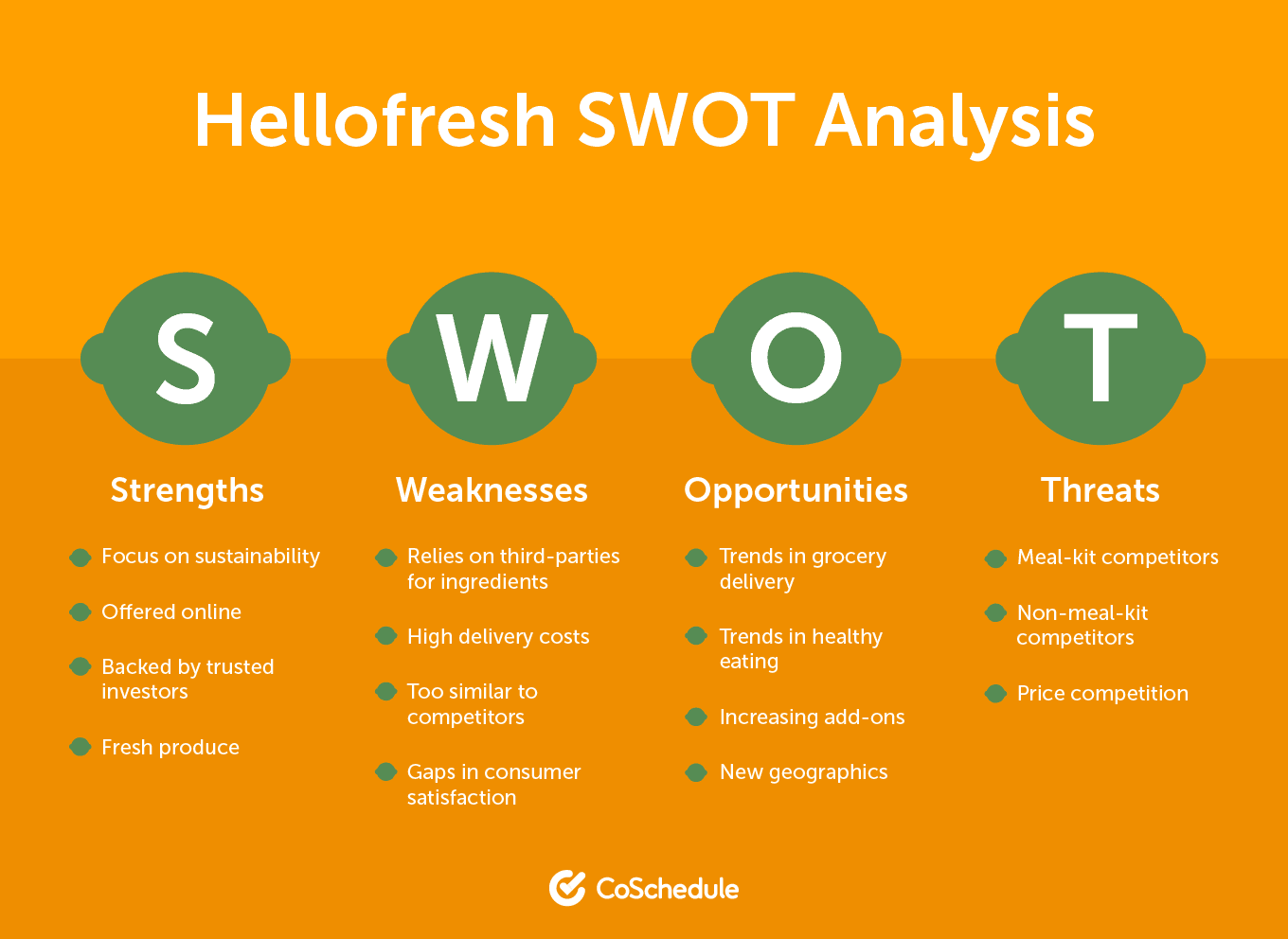
Strengths
One of HelloFresh’s biggest strengths is the work it does regarding sustainability. The company also strives to offer fresh produce to all of its customers.
In the technical aspect of business, their products are offered online, making ordering easier.
Finally, as seen in the company’s history, there is a strong financial position because trusted investors back it. This allows them more opportunities to spend resources on advertising campaigns and other aspects of marketing.
Weaknesses
HelloFresh relies on third-parties for ingredients, which means they don’t always control the produce they receive. Because of this, they’ve had some complaints about the quality of ingredients.
The company also has to juggle high shipping costs and other delivery expenses while trying to increase profit. This doesn’t come easy, as their strategy is similar to other meal-kit competitors.
Opportunities
HelloFresh has been able to take advantage of recent trends. For example, the trend of getting groceries delivered, along with the trend of eating healthier, has been highly beneficial for HelloFresh.
HelloFresh has the opportunity to increase more food options, along with add-ons. This includes soups, sides, desserts, wine, or even quick meals.
Finally, they have the opportunity to expand their efforts to reach new geographic markets. If they offer more diverse meal options, they can reach customers with different palates.
Threats
Perhaps the biggest threat to HelloFresh is competitors like Blue Apron, Home Chef, or Freshly. However, they’re also threatened by non-meal-kit food delivery services like Doordash and Uber Eats.
Because one of its most vital selling points is convenience, restaurants that offer food delivery negatively impact HelloFresh’s strategy. This requires HelloFresh to find ways to cut its pricing to stand out.
The fact that so many other competitors have similar pricing is another threat to HelloFresh. If they don’t find a different way to stay competitive, the competitors could edge them out.
HelloFresh Marketing Strategies
Go Back To The Basics
You can see through HelloFresh’s branding that they want to make the impression of a health-promoting and helpful company. They even use specific design aspects to make it appear that way.
According to color psychology, green stands for health, nature, and creativity, all elements that HelloFresh wants to portray. Even the logo is within a lemon, which shows customers how natural their products are.
HelloFresh also uses multiple advertising techniques to increase brand awareness and foster new relationships.
You can see how HelloFresh uses the sponsored Facebook ad below to promote their business. They even encourage viewers to engage with the post by having them vote for which recipe they like the most.
You can copy this portion of HelloFresh’s Marketing strategy by expanding your advertising efforts. Try to adapt any of the following into your current strategy:
- Print Ads
- Banner Ads
- Digital Ads
- Billboard Marketing
- Coupon Codes
- Newsletters
Harness The Power Of Influencers
Part of HelloFresh’s content strategy involves public endorsements by influencers. Celebrities like Mandy Moore, Audrina Patridge, and Mindy Kaling have all endorsed HelloFresh on social media and in commercials.
Below, you can see Annie Murphy starring in a HelloFresh commercial. Fans went crazy over it on Facebook, and the comments created worked as free testimonials.
To copy this aspect of HelloFresh’s marketing strategy, try finding influencers who would be great to work with. Ask yourself these questions when choosing an influencer:
- Do they fit in with my brand?
- How large is their audience/ fanbase?
- How much will they cost?
- Does the general public like them?
Break Up Your Pricing Strategy
HelloFresh’s marketing strategy involves taking measures to reach many different audiences with a variety of budgets. By creating flexible pricing plans they are able to target different-sized households and allow members to set how many recipes they receive each week.
HelloFresh also allows customers to adjust their orders, skip weeks, or cancel anytime. This, again, shows just how budget-friendly HelloFresh can be.
You can reach a wider audience, just like HelloFresh, by breaking up your pricing strategy. Of course, you’ll be marketing to your target audience, but try not to limit your audience too much.
If you can create multiple audience segments for your business to target, you could bring in more revenue. Just making a few tweaks to your pricing strategy can allow you to reach people you might not have before.
Steps on how to set your pricing strategy:
- Determine your goals
- Look at what your competitors are charging
- Analyze your target audience
- Consider what makes your products better than your competitors
- What makes them worth more money?
- Create the pricing strategy and execute it
- Take into account penetration pricing, sandwich pricing, and promotional pricing
- Adjust your strategy as needed
Expand Product Options To Appease Customers
With diverse meal options, HelloFresh ensures all of their customers get exactly what they need. They offer more than two dozen recipes each week and even offer snacks, sides, and wine.
HelloFresh has expanded their recipes to support low-carb, vegetarian, vegan, low-calorie, or even pescatarian diets. They also have plans for family-friendly meals or meals that don’t take long to make.
Recently, HelloFresh customers were mentioning that they wanted more side options for their favorite entrees. The company listened and launched their HelloCustom feature to allow customers more freedom to choose.
Their variety of recipes also allows them to bring in customers from many cultures. They offer Mediterranean, South America, and Italian dishes, and meals from other nationalities.
This allows customers to experience flexibility in their pricing while trying new foods they might not otherwise taste. By catering to their customers’ specific needs and wants, they’re able to maintain customer loyalty and reduce churn rate.
If you want to retain customers, copy HelloFresh’s marketing strategy and follow these steps:
- Take part in social listening
- Know what your products are worth
- Reward loyal customers
- Be transparent
- Respond to feedback (positive and negative)
- Anticipate your customers’ needs
Stand For A Cause Bigger Than Yourself
Another huge part of HelloFresh’s marketing strategy is their sustainability efforts. Of course, the company believes in creating a greener earth, but they also promote that fact to help marketing efforts.
A study by the University of Michigan discovered that meal kit companies, like HelloFresh, have a 25% lower carbon footprint than groceries bought from supermarkets do.
HelloFresh concludes the reason behind that statistic to be:
- Shorter supply chain
- Less food waste
- Efficient delivery
The company also committed to offsetting 100% of their carbon emissions and sourcing 100% renewable electricity. In fact, in 2021, HelloFresh reported a carbon emissions reduction equal to taking 6,967 cars off the road.
77% of consumers are motivated to purchase from companies committed to making the world a better place. In addition to that, 73% of investors look at efforts to improve the environment and society when making their investment decisions.
Take a page out of HelloFresh’s book by incorporating corporate social responsibility efforts into your marketing strategy. You can do that by
- Emphasizing diversity, equity, and inclusion
- Giving to charitable organizations
- Improving labor policies
- Making environmentally conscious investments
- Reducing your carbon footprint
- Volunteering
Make It Easy For Your Customers
One of the primary driving forces of HelloFresh’s marketing strategy is the convenience they offer to their customers. This can be seen throughout their entire process.
HelloFresh’s website makes it easy to customize your order before you place it. They also allow you to skip weeks if you need to (you’re out of town, have other dinner plans, etc.).
After placing your order, all you have to do is sit back and wait for it to arrive. Because the meal kits are delivered right to your door, you can skip the last-minute trip to the grocery store.
Everything you need for your meal comes in the kit, and you don’t have to worry about forgetting an ingredient. This also takes the stress out of meal planning during the week.
Lately, HelloFresh has expanded into “ready-to-eat” options for those who might not have the time to cook a whole meal. All of this makes it easy for customers to shop, create, and love their dinners.
If you’re trying to push customers down the sales funnel, follow the convenience portion of HelloFresh’s marketing strategy. Try to identify what’s keeping your customers from buying, and eliminate unnecessary steps within the purchase process.
Below are some tips on how you can make your business more convenient:
Below are some tips on how you can make your business more convenient:
- Allow online appointments or reservations
- Create easy access to customer service
- Offer curbside pickup
- Offer self-service options
- Promote fast (or free) shipping
- Streamline online and mobile purchasing
Take advantage of technology and learn to automate the above tasks to make it easier for your customers. This will also allow you to spend your time and energy on more pressing tasks.
As you’ve seen in this case study, HelloFresh has been able to succeed in a competitive market by adjusting their strategy. By using influencers, tailoring your products to customer needs, and being environmentally conscious, you too, can create a successful marketing strategy.
Now that you know what works, follow HelloFresh’s recipe to create your own marketing strategy. Unpack these lessons, and cook up something great.


